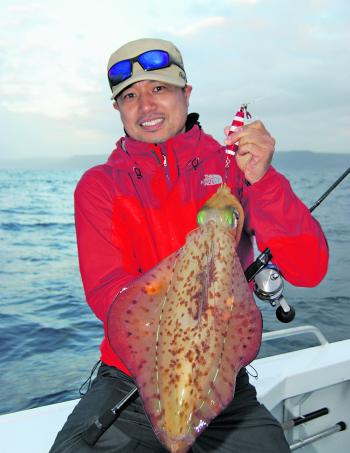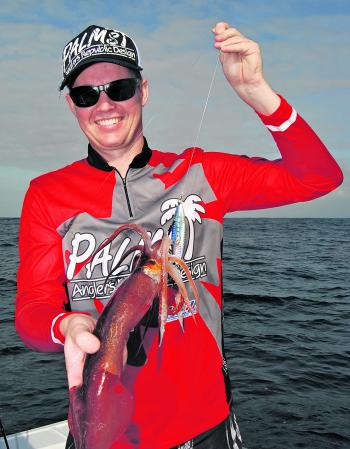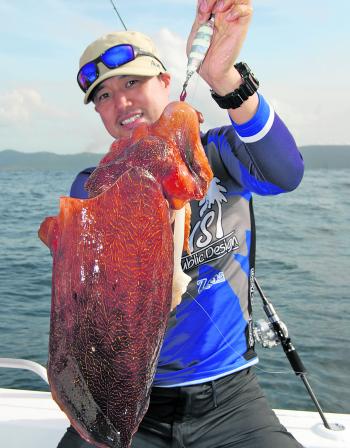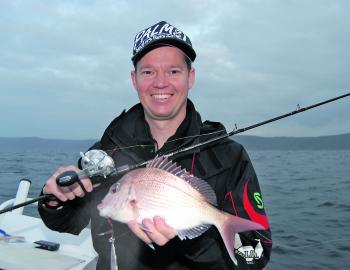There are not a lot of new ideas that come around in the world of fishing these days. Pretty much all methods and angles have been covered, at one time or another. So with fewer fish overall these days, it’s down to refining techniques. The result – fishing becomes more technical in the more populated areas.
With this in mind, Bryan and Yasushi from EJ Todd introduced me to a new form of fishing with metal lures. While it’s not a new concept, it’s become popular in Japan with effective results. Basically jigging, but not the style we know in Australia – drop the lure to the bottom and rip it back fast, for kings and whatever else grabs it. This method uses a slow twitching retrieve to entice the fish to grab your lure, rather than the instinctive chase and strike of the fast retrieve. It’s called slow jigging, or slow pitched jigging.
The jigs come in several shapes and a multitude of different colours. The main ones we used were in weights of 100g, 130g and 150g. They were centre balanced, giving them a strong flutter on the drop and a slower fall rate through the water column, falling in a horizontal position.
Some jigs come rear weighted with an irregular action during the fall and a faster sink rate. The Slow Blatt Long looks like a knife jig but flat on one side. The long body allows it to hop with a long slide to the side followed by a horizontal flutter. It combines both jigging styles, fast and slow, attracts the attention of fish with a fast upward movement and gets the bite on a slow drop.
We set a date to have a crack at a few fish in my local waters off the south coast. This method works best in waters of 30m or deeper, so a reef that ranges from 30-60m is usually quite productive, and was chosen for the majority of the day’s fishing. With a week of dead calm weather, a full moon and reported captures of many species few and far between, it wasn’t looking good.
The current was minimal and the wind a slight southwester so conditions were bordering on perfect. I chose to sit back and watch for a while just to see how this technique worked – get a feel for it before having a crack. The first drop got hit on the way down and turned out to be a pike. The next was a yellowtail which got Yasushi excited, even though he’s been to Australia many times. Similar fish are regarded as great sashimi in Japan.
Bryan scored a small snapper, barely legal but promising. Then came the rush of wrasse and tuskfish of various types and sizes, but nothing to get excited about. These jigs were getting hit on virtually every drop. Slimy mackerel were next to line up, along with leatherjackets and good old red rockies. One fish I thought would be a pest, the ever-present Sergeant Baker, are always a nuisance on soft plastics when chasing snapper. There must have been a bit of sand down there as a flathead even appeared.
I’d been watching for a while, and with a little practice, had the technique pretty much down pat. Let the lure sink until it hits the bottom then keeping the rod at 90 degrees, with a very short lift, take about half a turn on the reel to impart action on the jig. Let the tip fall then do it again all the way to the surface, or halfway if you want it back in the strike zone quickly.
The rod is very important, as your traditional jigging rods will not impart the action. Slow jigging rods have light tip sections and are quite parabolic in their action. The lure rises with the lift and wind then flutters back a short distance. It takes several lifts to cover even a metre of water, so the jig stays rising and fluttering in a small area, giving fish plenty of time to find their mark and attack.
I found it strange that I was getting extra weight on many of the drops, before getting hit by a fish of one type or another. Yasushi and Bryan were too, and we couldn’t work it out. I managed to stay connected to one of the weights and it turned out to be a squid. Then Yasushi and Bryan stayed connected, and it was squid coming in every couple of drops. They just loved it, particularly the jig in red with the luminous bands. We caught both arrow and calamari squid. By the end of the day, we had better than fifteen of these ink-spitting cephalopods.
Yasushi hooked one that didn’t want to come up – a fair sized cuttlefish. We only needed an occy now to cover the whole family, but still no decent fish.
All this commotion stirred up the locals, as my jig was nailed in the first metre of retrieve. A nice snapper about 2kg found its way to the boat, followed by another from Yasushi. Then we had tailor in 40m of water and more assorted species of bottom dwellers.
We were on our way back by 1.00pm. We didn’t set the world on fire with massive snapper, kings and mulloway, but who does in one trip? We did get hit or caught fish on almost every drop, which is unheard of. Not what we would call quality species, but these jigs and this technique had something that made fish want to bite them.
Back at the ramp, enquiring what other boats had caught that day, we smashed them. Boats came in empty, even on the lesser species. I would brand my first effort at slow jigging a success. I’d love to have a crack at this method on the reefs of the mid and north coast of New South Wales, for pearlies, trag and snapper. On the Queensland reefs, they would be deadly on just about everything from trout to trevally.
To work the jig effectively, match them to the right rods and reels. Even the terminals like hooks are important to get right.
The gear we used on the day were rods specially built for slow jigging, in the Metal Witch Quest range. The reels were Shimano Ocea Jigger 1500HG and Diawa Saltiga Overhead 10H, both high-speed retrieve. The reels matched to the rods and are super fast to effectively take up the line on hook-up, and set the hook.
The lines were colour coded braids, to easily work out the depth. This really helped retrieve speed and to notice hits on the way down, which happened on a regular basis. The diameter is thin for the breaking strain, which helps stay in contact with the jig. Especially in strong current you can feel every touch on the jig. We used Sunline PE Jigger ULT 8 in 35lb, and Super Braid 5 in 24lb, both 300m.
We used Sunline FC Rock 30lb leader, which is a favourite of mine in most situations. It’s tough with high abrasion resistance, thin and clear. We ran long leaders of 2-3m, which helped to give the jig a good stealth presentation, with plenty of distance between main line and leader. This helps when the jig is getting close to the rod tip.
The hooks were lethal. When you hook squid with standard hooks consistently, you know they’re sharp. They came about through collaboration between Palms and Decoy – the best hook and drop length for the various slow pitch jigs. We were using twin assist hooks, sometimes on both top and bottom of the jig for better hook-up rates.
They worked and the hook-up rate was excellent. These are the sharpest hooks I’ve ever used. I’m going to chase some up in bigger sizes and rig them on knife jigs, for kings, in the same manner as the slow pitch jigs. If they work, I think they’ll rarely miss another hook-up.
Slow jigging is a new technique in this neck of the woods, but I’m sure we’ll hear a whole lot more about it, with some solid captures in the future.
1
When a fish is on, these rods have plenty of power to get the fish to the boat. They still work the jig to extract its best action and are delicate enough to feel the slightest touch – rods made for a purpose.
2
For some reason, whopper squid were attracted to these jigs.
3
Arrow squid as well as calamari were equally enthusiastic.
4
Even the normally sedate cuttlefish liked the slow jig technique.
5
A bit of fun when two mini Sergeant Baker tackled the jigs.
6
A nice red that took a liking to the Slow Blatt.
7
The last thing we expected in 40m of water was a tailor.
8
Even smaller snapper took to the Blatts.
9
Better quality snapper came in after the early small ones.
10
This little fella had eyes bigger than its belly, taking on such a large jig.
11
Here’s some of the tackle used – the Slow Blatt S, Slow Blatt R and the Slow Blatt Long jigs, Metal Witch Quest rods, and the high speed reels, Shimano Ocea Jigger 1500HG and the Diawa Saltiga Overhead 10H.
Reads: 10186














